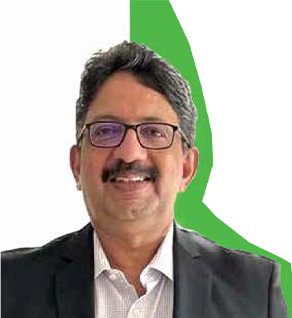India’s presence at the FIFA World Cup 2022
was a ‘green’ stadium
The L&T-rebuilt Ahmed Bin Ali (or Al Rayyan) Stadium
hosted 7 matches

Lionel Messi’s 1,000th career match and his mesmerizing goal to help Argentina beat Australia in the knockout stage of the FIFA World Cup 2022 had special relevance for India, for it happened on the L&T-rebuilt Ahmed Bin Ali
(or Al Rayyan) Stadium. Demolished in 2015 and reconstructed by the L&T–Al Balagh joint venture, the stunning open-air, 40,000-seat stadium that celebrates Gulf heritage in design hosted 7 matches in all, starting with the USA vs Wales encounter on November 21st, 2022. Located in the historic city of Umm Al Afaei, the Al Rayyan Stadium has one more claim to fame apart from its aesthetics: it is a ‘green’ stadium specially built to enhance the comfort of both the spectators and the players.
Unique. Environment-friendly. Sustainable.
In response to the growing clamour about the threat of climate change, the Al Rayyan Stadium embodies several sustainable, environment friendly features. “Thanks to its unique design and allied features, the stadium consumes approximately 40% less energy by minimizing demand through efficient energy supply to the building,” explains
L K Joseph (LKJ), Vice President & Head – Health, Residential & Commercial Buildings SBG, B&F IC, who was deeply involved in the project.


Thanks to its unique design and allied features, the stadium consumes approximately 40% less energy by minimizing demand through efficient energy supply to the building.
L K Joseph
Vice President & Head – Health, Residential &
Commercial Buildings SBG

Computational Fluid Dynamics (CFD) addressed the design challenge to cool the bowl with open oculus by ascertaining the cooling demand and selecting the necessary equipment. A 1:300 scale replica of the stadium was 3D-printed and tested in a specialist wind tunnel for aerodynamic performance. Within the tunnel, the model was systematically analysed with laser beams that recorded airflow over the design, enabling analysts to measure the temperature per tier and model variants like sweat produced and number of spectators to simulate optimal outcomes. This effort both decreased the cost and improved the environmental footprint.
Instead of a conventional individual cooling system for each building, the complex has a ‘District Cooling System’ (DCS) that distributes chilled water from a central source or the ‘energy centre’ to the stadium through a network of underground pipes to cool the facility. The centralized location of the DCS results in 50% less energy consumption, which in turn lowers greenhouse gas emissions. “The DCS is more efficient because it takes full advantage of the diversity in cooling demand for the various buildings and economies of scale,” elaborates LKJ.

A 30,000 Ton-Hr thermal energy storage tank stores and discharges energy as per the cooling demand, further enhancing energy efficiency. What’s more, the light-coloured Exterior Insulation and Finishing System (EIFS) reduces heat absorption. The stadium consumes 20% less water than international standards, achieved by adhering to the Global Sustainability Assessment System (GSAS) norms for water fixtures and water flow. The precincts are watered using recycled wastewater drawn from the stadium. Even during construction, the project team adopted several sustainable measures like noise control, using treated sewage water for dust control, water conservation, waste management, and such. About 15% of the building materials has recycled content. Little wonder, therefore, that the stadium achieved a GSAS 4 rating for design, construction, management, and energy efficiency!
Cooling an open-air stadium in the heart of the desert
With the November temperatures in Qatar expected to be around 30°C, during which time the World Cup was planned, the need was for a cooling arrangement to make both playing and watching comfortable. The temperature on the field of play is controlled by diffusing chilled air through the nozzles installed on the periphery of the field of play, which can be adjusted at certain angles to ensure uniform air flow to keep temperatures at desired levels. The cooling systems at both the bowl and field of play are fully automatic, controlled through a Building Management System (BMS) by Standard Effective Temperature and Wet Bulb Globe Temperature settings.
Overhead ductwork was redesigned to blow air from underneath the seats, reducing cooling loads by 40%, which was further aided by an innovative façade that is a mesh-like, permeable material built into a wind shield that optimizes airflow into the space. The façade was value-engineered to simplify the patterning, improve buildability, and yet retain its visual integrity.

Working comfortably too
In total, some 34,000 workmen, drawn from various nationalities, were inducted into the project during the construction phase, with numbers peaking at about 8,000, but throughout, the treatment meted out to them was of a high standard. Their accommodation was air-conditioned and equipped with a dining hall, recreation facilities, a fitness centre, laundry facilities, and a grocery store, and they had air-conditioned transportation to and from the site, all at par with international standards following strict guidelines provided in the Supreme Committee’s (SC’s) Workmen Welfare Standards. “While the workmen were recruited strictly as per the SC’s Ethical Recruitment Standards, we ensured proper safety & welfare inductions and training for workmen for them to understand their rights and assignments,” informs Sachin Deshmukh, Assistant Manager – Workmen Welfare. “Many who joined us as unskilled or semi-skilled workmen were trained in areas like lifting supervisors, riggers, operators, etc., and their pay scales were revised according to their upgraded skills.”

Many who joined us as unskilled or semi-skilled workmen were trained in areas like lifting supervisors, riggers, operators, etc., and their pay scales were revised according to their upgraded skills.
Sachin Deshmukh
Assistant Manager – Workmen Welfare



Regular audits were conducted by the SC and periodic audits by the Building and Wood Workers’ International team to evaluate compliance to the welfare standards. “Our compliance was acknowledged and no critical observations were made or recorded,” LKJ notes proudly. Workmen issues relating to accommodation or the project site were addressed by workmen welfare forums having their elected representatives to act as intermediaries between them and the welfare officer.
The curtains have come down on the FIFA World Cup 2022 with the world celebrating the sight of Messi holding the Jules Rimet trophy aloft. The entire upper tier of the stadium, which is a temporary metal-and-bolt system, will now be taken down and those 15,000 seats will be donated by Qatar to other nations to help develop their sporting infrastructure. Another impressive sustainable highlight!